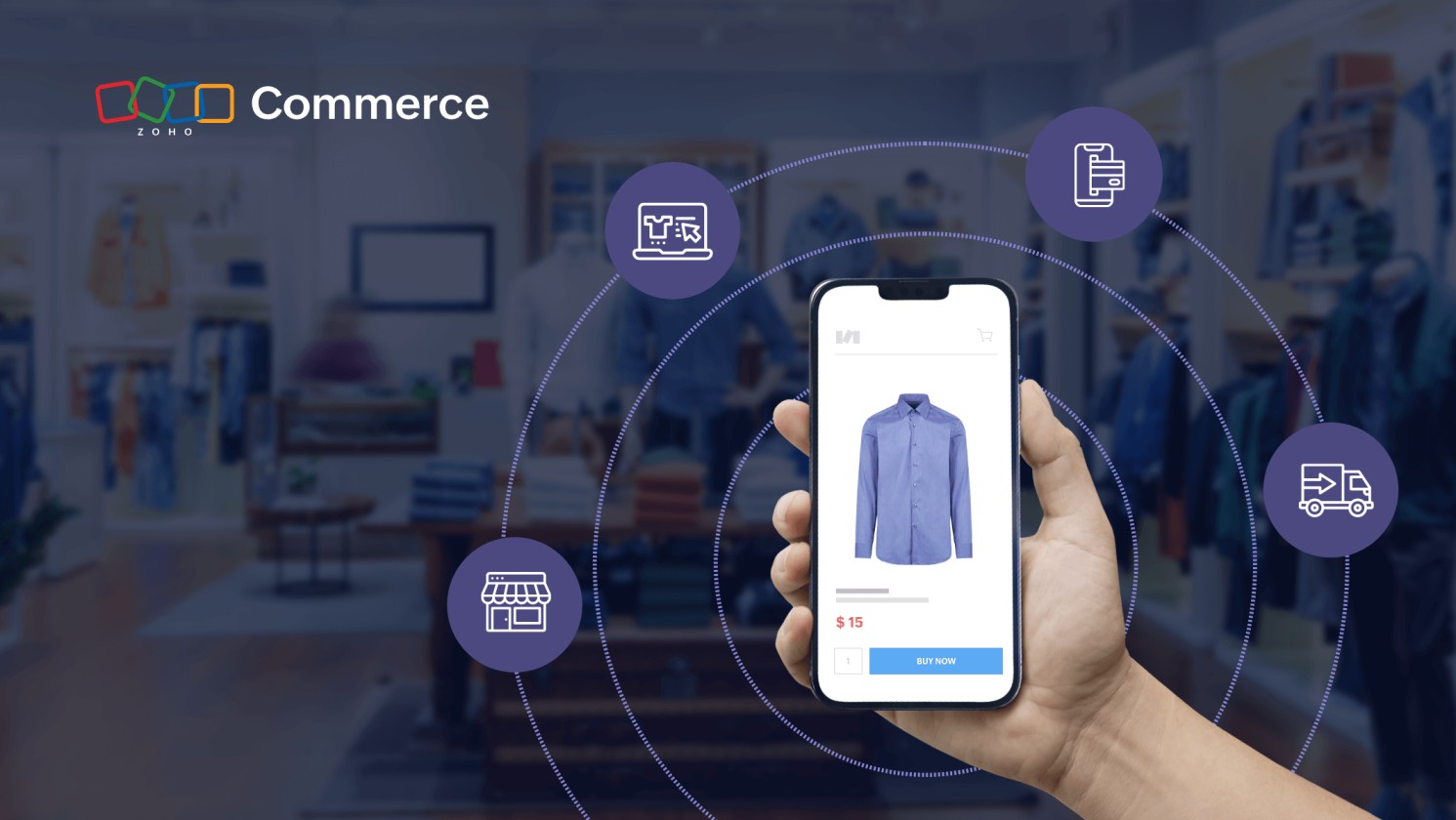- HOME
- Ecommerce insights
- What is ecommerce? A guide to exploring the digital marketplace
What is ecommerce? A guide to exploring the digital marketplace

Ecommerce has revolutionized how we shop and conduct business. This has helped businesses of all kinds reach a global audience and has enabled individuals to shop from their homes. In this article, we will explore the fascinating world of ecommerce and share pointers to help you if you are looking to navigate the digital marketplace.
From understanding the definition of ecommerce, learning its history and evolution, and its benefits and drawbacks, to learning more about setting up a store, this article will cover all the key aspects of ecommerce and provide insights on growing and succeeding in the digital marketplace.
What is ecommerce?
Ecommerce, or electronic commerce, is a rapidly growing and exciting way of doing business online. It has completely changed how we buy and sell products and has created a new industry.
An ecommerce business is any online venture that involves selling goods or services over the internet. It can include both physical products like clothes or electronics, as well as digital items such as software or music downloads, and services.
The rise of ecommerce has been driven by advancements in technology and the internet, making it easier for businesses and consumers to connect and conduct transactions online. Ecommerce provides convenience to customers. Additionally, it offers a wider range of products and services compared to traditional brick-and-mortar stores.

History of ecommerce
Ecommerce has evolved from a fledgling industry to a massive one, with billions of dollars being spent each year on online purchases. Here's a timeline of key events in the history and evolution of ecommerce.
1970s-1980s: The beginning of home internet services
CompuServe was the first to bring home internet services to the public in the late 1970s, allowing ecommerce to establish itself. It set the trends when it comes to live online chat room. It was dubbed as an "an incubator of online commerce," and thus became a precursor to the internet-driven shopping era. However, the technology was not yet sophisticated enough for widespread adoption, and ecommerce remained a niche market for the next two decades. This early form of ecommerce was slow, limited in scope, and expensive, but it was a major step forward in providing people the ability to shop from the comfort of their homes.
1990s: The early days of ecommerce
The birth of the internet marked the beginning of a new era for ecommerce. The World Wide Web made it easier for people to access information and connect with one another, and as a result, ecommerce began to grow.
The first notable ecommerce transaction took place in 1994 when a student at Stanford University used the internet to sell a CD of Sting’s album Ten Summoner’s Tales. This was a significant moment in the history of ecommerce as it marked the birth of online shopping.
In the same year, one of the biggest ecommerce players, Amazon, was founded, and then went public in 1997. Amazon initially started off as an online bookstore but evolved gradually to become a leader in the ecommerce business. Forbes states, Amazon accounts for 37.8% of ecommerce sales, the largest share of all ecommerce corporations as of February 2023.
The introduction of eBay in 1996 marked another milestone in the evolution of ecommerce that saw auction sites become popular among customers around the world. The ecommerce industry was no longer a distant dream.
2000s: The emergence of mobile commerce
Over the next few years, ecommerce continued to grow, but it was not until the late 1990s and early 2000s that it really took off. This was due to the rapid growth of the internet and the increased availability of online payment systems. The introduction of smartphones and other mobile devices in the 2000s changed the way we shopped online. Mobile ecommerce made it possible for people to shop from anywhere, at any time, and opened up a new world of opportunities for businesses.
In the early 2000s, ecommerce experienced a boom as more and more people started shopping online. This was also the time when online payment systems became more sophisticated, making it easier and safer for people to make online purchases. At the same time, companies like PayPal emerged, while eBay began to get globally popular, allowing people to buy and sell goods and services on a global scale. Three other crucial developments took place in this period which would have a huge impact on ecommerce trends.
2000:Google announces AdWords, which allows advertisers to pay for ads on Google search results pages. This leads to an increased focus on digital marketing and advertising by businesses.
2007:Facebook starts allowing users to create Pages, which allow them to share content with their friends and followers. This helps popularize social media amongst businesses and consumers alike.
2007:Apple introduced the first iPhone, which quickly became one of the most popular devices for mobile ecommerce.
2010s: The rise of social media ecommerce
The 2010s witnessed an unparalleled growth of ecommerce. The percentage of ecommerce in total retail sales doubled in the United States between 2010 and 2020. Mobile commerce continued to grow at an exceptional pace. Social media platforms, like Facebook and Instagram, became major players in the ecommerce world. The ability to connect with friends and family as well as businesses made social media a valuable tool for shopping and marketing.
In 2016, Facebook launched its first ecommerce platform, Facebook Marketplace, which allowed users to buy and sell goods to one another. Digital and phone payment methods, like Google Wallet and Apple Pay, made shopping and paying convenient for customers. In the following years, many businesses started using social media platforms as a way to reach customers and sell their products. Brands started innovating to establish their online presence and make it known. Then, the world and ecommerce was unexpectedly left overwhelmed by an event.
2020s: The pandemic and its effects on ecommerce
The COVID-19 pandemic profoundly impacted ecommerce. With many people staying at home and avoiding physical stores, ecommerce became a critical tool for businesses to reach customers. Amidst lockdowns and the fear of stepping out, people chose to shop from their homes, placing safety and convenience above everything else. Ecommerce's share of global retail trade shot up from 14% in 2019 to 17% in 2020. In 2020, ecommerce sales reached an all-time high, and many businesses that had never sold online before were forced to quickly adapt to the changing landscape.
Over time, more and more companies started offering their products and services over the internet, taking advantage of digital marketing techniques to reach their target audience easily. There was an uptick in digital payments as well, with many preferring contactless payments to feel safe.
The growth was truly unprecedented. Now that you know how ecommerce evolved, you must also understand that ecommerce, like any other consumer technology, has its own benefits and drawbacks. Let's delve into those.
Benefits of ecommerce
The rise of ecommerce has brought many benefits to both businesses and consumers, making it an essential part of modern commerce. Here, we will take a closer look at the ways in which ecommerce is beneficial and how it has changed the way we shop and do business.
Here's how entrepreneurs have benefited from ecommerce:
Increased sales
With an ecommerce business, companies can reach customers 24/7 from anywhere in the world, offering up their products or services at any time of day or night.
- This increased accessibility means more potential for sales, which can be a huge benefit to businesses looking to grow their customer base and revenues.
Global reach
It provides an opportunity to reach customers outside their home countries or local areas who may not have access to their physical stores.
By utilizing global payment solutions such as PayPal or Stripe, businesses can easily accept payments from international customers in different currencies.
Cost effective
Businesses can drastically reduce the costs associated with renting or purchasing a physical space, eliminating the need for costly construction and labor, too.
You also won't have to spend money on stocking shelves, recruiting employees, or investing in expensive overhead costs. This helps you focus resources on digital marketing campaigns that will drive customers directly to your online store
Data collection
Ecommerce has changed the way businesses collect data on customer behavior, preferences, and demographics. A good ecommerce platform helps businesses collect consumer data in the form of clicks, cookie consent pop-ups, heatmaps, and through questionnaires. Then, this data can be used to personalize their shopping experience with effective product recommendations.
- With the growth of digital technology, many companies, both small and large, have turned to ecommerce as a way to increase their customer base and expand their reach. Enhanced data collection can help businesses better target their niche audience.
Inventory management
With automated inventory management tools integrated in the backend of websites, ecommerce makes it easier than ever to stay on top of your inventory needs.
- Quickly access data regarding which products are sold most frequently to track stock levels and make informed decisions about how much stock you need and how often it needs to be replenished. It also gives you an idea of popular products, allowing you to plan sales of other products as well.
Businesses clearly benefit significantly from ecommerce, but so do consumers. This is how consumers have benefited from ecommerce:
Convenience
Ecommerce has opened up a world of possibilities for shoppers who may not have access to traditional brick-and-mortar stores or need more flexible shopping options.
Businesses can offer convenience, variety, speed, customization, and cost savings—all without having to go into a store physically—making it simpler than ever before for customers to find what they're looking for quickly and easily.
In addition, ecommerce stores can operate 24/7 so customers can shop when it's most convenient for them. Chatbots on websites also make it possible to get responses to basic queries any time of the day and night.
Comparison shopping
Shoppers can access dozens of stores with just one click through an online marketplace. Plus, customers can easily search for whatever they need by simply typing keywords into a search bar, saving them time.
By having access to this information, shoppers can make more informed decisions about their purchases and get the best value for their money.
- Customers no longer need to spend hours visiting physical stores just to find what they’re looking for at the best price possible.
Detailed product information
By providing detailed product descriptions and customer reviews, businesses can help their customers make informed decisions when shopping online.
- Having access to this type of information can give potential customers the confidence they need to purchase from a business, which in turn helps increase sales and grow the business’s bottom line.
Order tracking and customer service
With tracking information, customers have access to real-time updates about when their package will reach them or if there’s been a delay in shipping due to unforeseen circumstances like inclement weather.
- Customer service is often more accessible through email or chat than other traditional forms of communication such as phone calls or snail mail letters.
Mobile optimization
Mobile optimization enables consumers to access websites quickly and easily from their phones or tablets, without sacrificing quality of the user experience. It is a must-have for ecommerce businesses looking to stay competitive in today’s market.
With mobile optimization, ecommerce businesses can provide an enhanced user experience on their platform by optimizing navigation menus and buttons so they are easy to use on smaller screens like smartphones and tablets.
This makes it easier for customers to browse products and complete purchases on the go, and receive updates about new offers from their favorite brands with just a few taps of their finger.
With the ongoing shift towards online shopping, it's important for businesses to understand the advantages of ecommerce and how to effectively leverage them to succeed in the digital marketplace.
Challenges of ecommerce
While ecommerce offers many opportunities for businesses to increase their reach, improve the customer experience, and increase sales, it's important to remember that it also comes with its own set of challenges, such as competition and the need to adapt to rapidly changing technology.
There are several challenges associated with ecommerce, including:
Security concerns: Online transactions require sensitive information such as credit card numbers and personal information, which can be vulnerable to hacking and identity theft. This can lead to a loss of customer trust and damage to a company's reputation.
Shipping and logistics: Ecommerce businesses need to handle shipping logistics to get their products to customers, which can be challenging and costly. This includes managing inventory, fulfillment, and returns.
Competition: The ecommerce market is highly competitive, with many businesses vying for the attention and loyalty of customers. This can make it difficult for new businesses to establish themselves and for established businesses to maintain their market share.

High customer expectations: Online customers have high expectations for fast and efficient service, accurate product descriptions, and easy returns. Failing to meet these expectations can lead to negative reviews and a loss of business.
Limited customer interaction: Ecommerce businesses don't have the same opportunities for face-to-face interactions with customers as brick-and-mortar stores do. This can make it more difficult to build personal connections with customers and to get direct feedback on products and services.
Dependence on technology: Ecommerce businesses rely heavily on technology, from their website to their inventory management systems. Technical issues or outages can disrupt business and lead to lost sales. Your IT overheads or other related expenses could limit you from growing, especially when you are already growing and wouldn't want an additional expense to eat into your operational or marketing budget.
Legal and regulatory compliance: Ecommerce businesses must comply with a variety of laws and regulations, including those related to sales tax, data privacy, and consumer protection. Failing to comply can result in fines and legal action. If you run an international business, you will need to comply with the regulations of multiple countries.
Marketing: Ecommerce businesses need to develop effective marketing strategies to attract and retain customers. This can be a significant ongoing investment of time and resources.
Returns and refunds: In ecommerce businesses, the process of returns and refunds can be challenging for both the business and the customer. Customers may have to pay for return shipping and may not be able to return items that are not in their original condition. Businesses may have to deal with the cost of processing returns and restocking products, and may also face the risk of fraud or abuse of the return policy.
Additionally, businesses may also encounter challenges in managing the reverse logistics and managing the returned inventory. It can also impact the overall profitability of the business if not managed efficiently.
Growth of ecommerce
No matter the challenges, the world of ecommerce has been one of constant change and growth. It has continued with the rise of mobile apps and the widespread adoption of smartphones, allowing people to shop online at any time and from anywhere. Today, ecommerce has become an integral part of the global economy, with billions of dollars worth of goods and services being sold online every day.
Forrester predicted that by 2023, B2B online commerce in the United States will reach $1.8 trillion. The global B2C e-commerce market size is estimated to expand at a compound annual growth rate (CAGR) of 9.7% between 2021 and 2028.
You may be a businessperson ready to jump on this bandwagon, but consider a few factors beforehand.
Factors to consider before selling online
Starting an ecommerce store is a great way to get your goods and services out to the world, but it's important to consider several factors before launching your business.
Product or service offering
Consider the products or services you plan to sell online. Make sure there is a market for your products and that they are in demand. Identify a niche or a specific market and understand the demand, competition, and trends within it.
Legal requirements
Understand the legal requirements for operating an ecommerce business, such as obtaining a business license and registering for taxes. Make sure you are compliant with all local, state, and federal regulations, including data protection and consumer protection laws.

Scalability
The goal should be to find a platform that can easily adjust to accommodate growing demand while still providing customers with a great user experience. If you have too many customers on one platform, it could cause slow loading times and outages, both of which can cost you potential sales.
By considering these factors, you'll be better prepared to launch and manage a successful ecommerce business. It's important to do your due diligence before starting an ecommerce store, to ensure you have a solid business plan and the resources and knowledge to make your online store a success.
Besides the above points, it's also important to consider your own resources and capabilities when deciding to sell online. Make sure you have the time, money, and expertise to manage an ecommerce business before launching one.
Setting up your store
Setting up your ecommerce store can seem daunting, but it is a relatively straightforward process for beginners. Here are the steps to follow:
Setting up your ecommerce store can seem daunting, but it is a relatively straightforward process for beginners. Here are the steps to follow:
Choose a platform: There are several ecommerce platforms to choose from. Each platform has its own set of features and costs, so research which one would be the best fit for your business.
Register a domain name: A domain name is the address of your website, and it needs to be unique and easy to remember. You can register a domain name through a domain registrar, such as GoDaddy or Namecheap.
Set up hosting: Hosting is the service that keeps your website online, and it can be purchased from the same company where you registered your domain name or through a separate hosting provider.
Design your website: Once you have your platform and hosting set up, you can start designing your website. You can choose from premade templates or hire a web designer to create a custom design.

Add products: You can add products to your store using the platform's built-in product management tools. You will need to provide product information, such as descriptions, images, and pricing.
Set up a payment gateway: To accept payments, you will need to set up a payment gateway, such as PayPal or Stripe. This will allow customers to securely enter their credit card information and complete a purchase.
Test your website: Before launching your website, make sure to test it thoroughly. Test the checkout process, payment gateway, and any other features to ensure everything is working properly.
Optimize your website for SEO: Optimize your website for search engines to increase visibility and attract more customers. This includes optimizing product pages, images, and website content for relevant keywords.
Launch your website: Once you have completed all of the above steps, you can launch your website and start accepting orders.
- Marketing and promotion: Create a marketing plan and start promoting your website, this includes social media marketing, email marketing, influencer marketing, and paid advertisements.
Tools and technologies for ecommerce
With various technological advancements, starting an ecommerce business is easier than ever. The success of such businesses relies heavily on the tools and technologies available to them. But what tools and technologies do you need?
Ecommerce platform
An ecommerce platform is a software solution that provides merchants with the means to manage their online store, process transactions, and streamline operations. These systems come with drag-and-drop features to build navigation menus and displays, and also have features such as product catalogs, order tracking systems, payment processing options, marketing solutions, analytics tools, and more. They are designed to give merchants greater flexibility over how they manage their online stores while providing customers with an improved shopping experience.
Payment gateway
Payment gateways are a critical element of any ecommerce business. They enable customers to safely enter their credit card information and complete transactions with confidence, while also providing merchants with an efficient way to process orders quickly and accurately. Payment gateways come in many forms, including specialized software applications as well as integrated solutions that work directly within popular ecommerce platforms. Regardless of which type you choose, they offer essential features such as fraud protection, automated billing management, and more.
Email marketing software
Email marketing is a form of direct digital communication between businesses and their customers or prospects. It allows companies to send promotional content, offers, newsletters, and other necessary messages directly to their target audiences through email. By leveraging this powerful tool, ecommerce businesses can increase revenue by creating personalized campaigns that engage their customers in meaningful conversations.
Using email marketing software helps businesses stay on top of their customer engagement with automated emails, segmentation capabilities, A/B testing options, analytics tracking, and more.
Analytics and tracking software
Analytics and tracking software can help entrepreneurs understand who their customers are, what they are buying, how much they are spending, where they come from, and how often they visit the website. This data can then be used to create strategies around product offerings, marketing campaigns, customer service initiatives, supply chain management, pricing tactics, and more. By understanding their customers better than ever before, entrepreneurs can easily increase profits.
Product information management (PIM) software
Product Information Management software provides businesses with a repository for storing, managing, and sharing product information across multiple channels. With PIM software, businesses can ensure all product information is accurate, consistent, up to date, and relevant for potential buyers, helping them find just what they’re looking for when shopping online.
Inventory management software
Inventory management software allows businesses to track their inventory in real time, allowing them to make more informed decisions about how much product they need on hand at any given time. This type of software helps keep businesses from overstocking their shelves or running out of products during peak sales times, which could be damaging to a company’s image. It also helps with forecasting, giving business owners an idea as to what kinds of products are selling well and which might not be as profitable.
Marketing and analytics tools
When it comes to marketing and analytics for an ecommerce store, there’s no shortage of options to choose from. From powerful data visualization tools that give insights into customer behavior, to email marketing services that allow you to reach out directly to potential customers, the possibilities are seemingly endless. In addition, there are numerous automation solutions that streamline online sales processes and boost efficiency. Investing in these tools will help your ecommerce business stay ahead of the competition. Examples include Google Analytics, MailChimp, and SEMrush.
SEO tools
SEO is a crucial part of marketing. It allows businesses to make sure that their websites appear higher in search engine rankings so that more potential customers can find them. It's important for any ecommerce business owner to understand what SEO is and how it works so that they can ensure their website is optimized for maximum visibility. Specific SEO strategies such as keyword research, link building, content optimization, and analytics can be used to effectively boost your website’s ranking in SERPs. Examples of SEO tools include Google Analytics, Ahrefs, and SEMrush.
Customer relationship management (CRM) software
CRM software helps ecommerce businesses track customer contact information, purchase histories, and other data in one central location. This data can be used for targeted marketing campaigns or product recommendations tailored specifically for each customer. In addition, CRM solutions provide automated processes like lead scoring and segmentation which can help teams reach out to prospects at just the right time with just the right message. Some popular CRM software include Salesforce and Zoho CRM.
Shopping cart software
Shopping cart software can be tailored to fit almost any business need. From basic features like product management and payment processing, to more advanced capabilities such as order tracking, shipping rules, and customized checkout processes; there are endless possibilities for creating a personalized ecommerce experience. With the help of these tools, you can quickly set up your storefront and begin selling with ease.
Order management system (OMS)
An order management system (OMS) is an automated platform that helps businesses manage orders from start to finish. An OMS automates processes such as inventory tracking, customer communication updates, and payment processing so businesses can focus on their core operations instead of managing mundane tasks. It also helps streamline the entire order process from when an item is ordered to when it’s delivered, ensuring customers get their items in a timely manner without any hiccups along the way.
Security software
Security software works by monitoring incoming traffic on your website to detect malicious activity or suspicious patterns that could indicate a breach or attack. This type of software can also encrypt customer data so no one else can access it, as well as provide extra layers of protection against viruses and malware attacks. Examples of security software include web application firewalls, SSL/TLS certificates, and intrusion detection systems.
Content delivery network (CDN)
CDN is a service designed to accelerate the delivery of digital content such as images, videos, web pages, audio files, and more. CDNs are composed of geographically distributed servers that allow for faster loading times for web pages resulting in an improved user experience. By leveraging CDNs, ecommerce businesses can ensure their product listings load quickly on all devices and browsers, no matter where customers are located. Additionally, CDNs offer enhanced security measures that protect websites from malicious attacks or hackers.
Fraud detection software
Fraud detection software uses advanced algorithms and machine learning to detect potential fraudulent activity by analyzing customer data such as payment histories, IP addresses, order values, and shipping information. This allows ecommerce businesses to easily identify suspicious activity before it becomes a problem, saving time and money in the long run. Examples include machine learning-based systems, IP blocking, and address verification.
Backup and recovery solutions
Backup and recovery solutions are designed to protect your data from loss or corruption due to external factors or malicious attacks. With these solutions, you can safely store important information such as customer profiles, order histories, financial records, product inventories, and more. Additionally, they provide a way to quickly restore data if it gets corrupted or lost due to technical difficulties or other unforeseen issues.
Two-factor authentication (2FA)
Two-factor authentication takes the traditional username and password setup used by many businesses and adds an additional layer of protection. By requiring users to enter a code sent directly to their device or email address, it provides extra assurance that only authorized individuals are accessing accounts. This can help better protect customers’ personal data as well as any sensitive business information stored within a company’s systems.
A good ecommerce website should have these elements integrated with the online store so it has a strong backend for the business. This will allow you more time to focus on the core business than worry about the technical aspects and operational issues. Learn more about how Zoho Commerce addresses these business concerns with a string of solutions on its backend.
Analyzing and growing your business
Analyzing and growing an ecommerce business involves several key steps:
➤ Identify key performance indicators (KPIs): Identify the metrics that are most important to your business, such as website traffic, conversion rate, customer acquisition cost, and lifetime value.
➤ Optimize your website: Use data and customer feedback to optimize your website for better conversion rates, including testing different layouts, calls to action, and product descriptions.
➤ Increase traffic: Use digital marketing strategies to increase website traffic and attract more customers, such as search engine optimization (SEO), pay-per-click advertising (PPC), and social media marketing.
➤ Test and experiment: Continuously test and experiment with new marketing strategies, products, and pricing to identify what works best for your business and customers.
➤ Diversify your product offerings: Diversify your product offerings to attract different customer segments and increase overall revenue.
➤ Invest in technology: Invest in technology to automate and streamline your business processes, such as inventory management and accounting.
➤ Continuously improve: Continuously analyze and improve your business to stay ahead of the competition and meet the changing needs of your customers.
Conclusion: Unlocking the potential of online commerce
Ecommerce is an exciting, ever-evolving field that presents endless opportunities for business owners and consumers alike. It's no wonder this industry has enjoyed such explosive growth over the past few years. It is a powerful tool for businesses to reach customers around the globe. If you're looking for a way to increase revenue or simply find convenient ways to shop, exploring the online ecommerce world should be at the top of your list. It will provide you with an opportunity to expand your business, gain insights from data analytics, and emerge as a powerful brand. Use it to your advantage and stay ahead in the digital space.
Don't miss out on the opportunity to expand your business and reach new customers. If you seek more information, write to marketing@zohocommerce.com.
